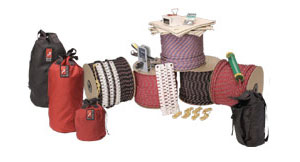
Life safety rope is an essential tool for rescue operations. It is your responsibility to learn and understand the capabilities and limitations of your life safety rope before using it. Be sure to read the manufacturer’s instructions for the use, care and maintenance. Always double-check that the specifications of the rope match the intended use.
Keeping your rope clean is essential. Dirt rubbing into and against the fibers of your rope will deteriorate it. Here are some suggestions from PMI for cleaning static kernmantle rope.
Lubricate it: Ropes may dry out and lose some flexibility as a result of washing. You can prevent this by occasionally adding a little fabric softener (about a cup of Downy Fabric Softener) to the rinse cycle during rope washing. Do not use more than this, or it might damage the rope.
Dry it: Dry your rope in a clean, dry area out of direct sunlight. Avoid: (1) commercial dryers, (2) placing wet ropes on a concrete surface, and (3) exposure to exhaust fumes. For best results, the rope should be laid in a loose coil or coiled around two objects in a low-humidity environment.
Write it down: Remember to record the cleaning on the Rope Log.
Keep it clean: After repacking, store your rope in a clean, dark, dry environment, away from exposure to acids, other harmful chemicals, noxious fumes or other abuse.
NOTE: Always follow the manufacturer’s instructions for use, inspection, care and maintenance of your rescue rope. Your life (and the lives of others) may depend on it, so take it seriously.




 As a first responder, it’s your worst nightmare… pulling up to a scene of a building collapse with a woman trapped under a beam screaming out for her child who’s buried in the rubble. That’s what happened yesterday in a small town in Arkansas that’s located about 55 miles west of Little Rock. With an incident like this – or the recent tornados with destruction everywhere in sight – would you know how to make the best use of the tools on your apparatus while waiting for USAR back-up?
As a first responder, it’s your worst nightmare… pulling up to a scene of a building collapse with a woman trapped under a beam screaming out for her child who’s buried in the rubble. That’s what happened yesterday in a small town in Arkansas that’s located about 55 miles west of Little Rock. With an incident like this – or the recent tornados with destruction everywhere in sight – would you know how to make the best use of the tools on your apparatus while waiting for USAR back-up? The Orange (Texas) Fire Department recently completed Roco’s Fast-Track™ 120 course, which is arguably the ultimate rope rescue training experience.
The Orange (Texas) Fire Department recently completed Roco’s Fast-Track™ 120 course, which is arguably the ultimate rope rescue training experience. 
 With a large concentration of industrial facilities within its response area, the Orange Fire Department has a unique responsibility to the community as well as the surrounding industries who play such a vital role in the local economy. In delivering the highest level of service, it is important for OFD Firefighters to be trained in both Confined Space and Rope Rescue techniques.
With a large concentration of industrial facilities within its response area, the Orange Fire Department has a unique responsibility to the community as well as the surrounding industries who play such a vital role in the local economy. In delivering the highest level of service, it is important for OFD Firefighters to be trained in both Confined Space and Rope Rescue techniques. These pictures are from the Enterprise Products (Port Allen, LA) class earlier this week at Roco Training Center. They scheduled a private “Refresher” course for the rescue team. It was a great class and an energetic group!
These pictures are from the Enterprise Products (Port Allen, LA) class earlier this week at Roco Training Center. They scheduled a private “Refresher” course for the rescue team. It was a great class and an energetic group! 



